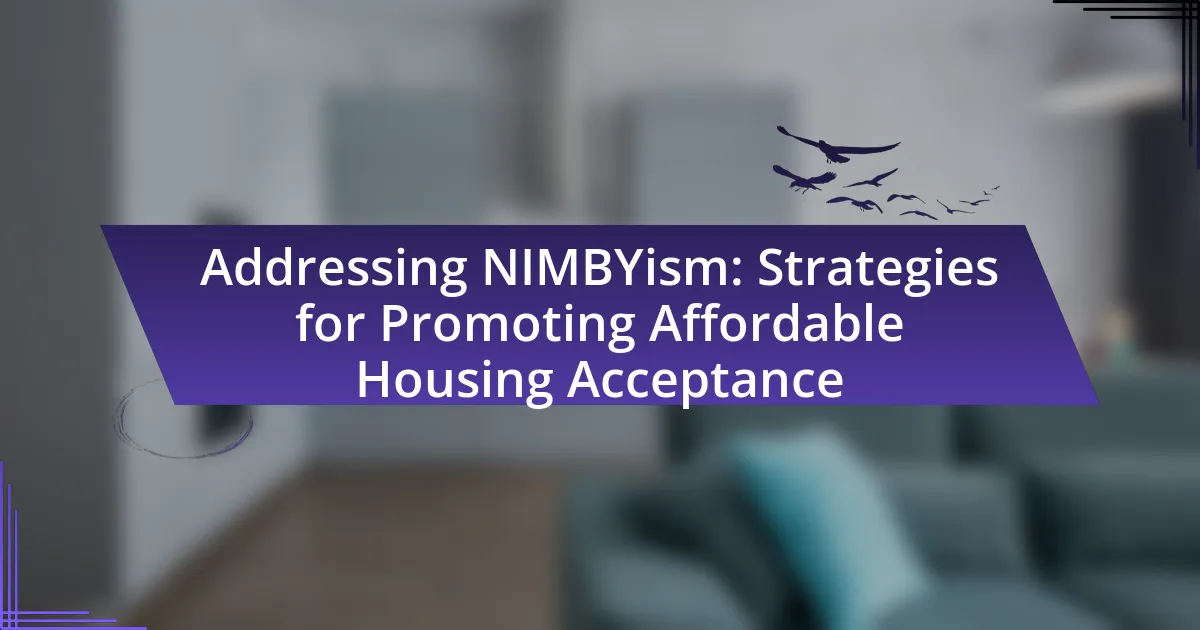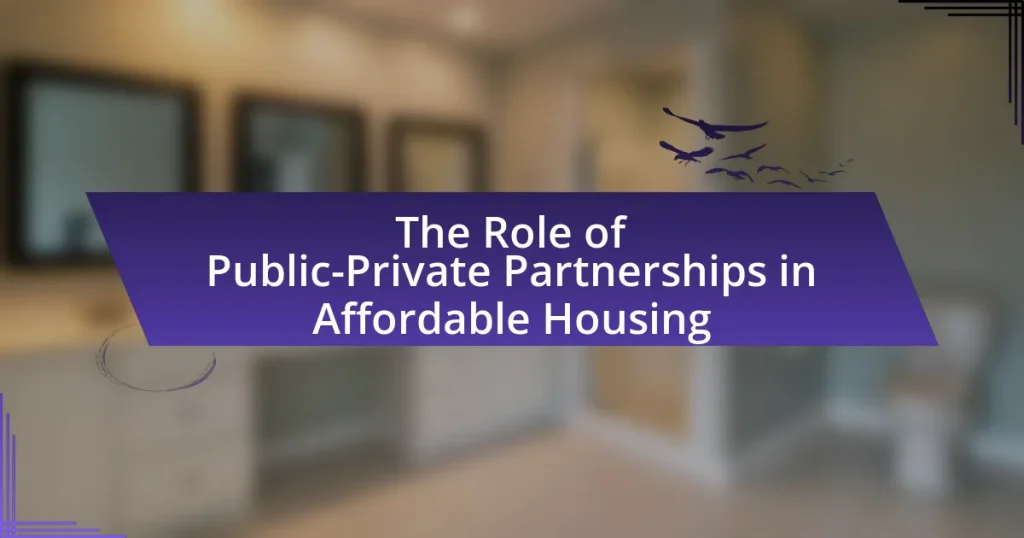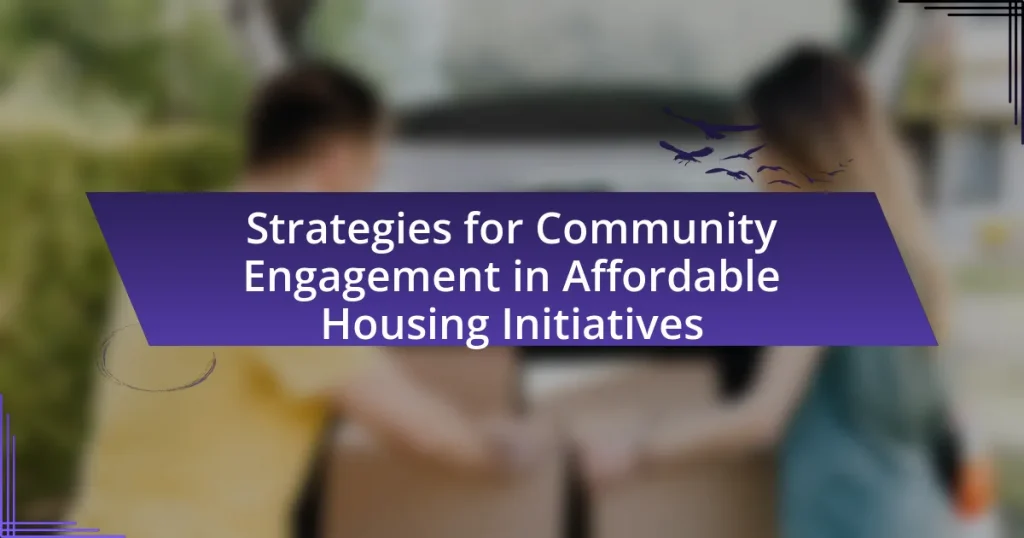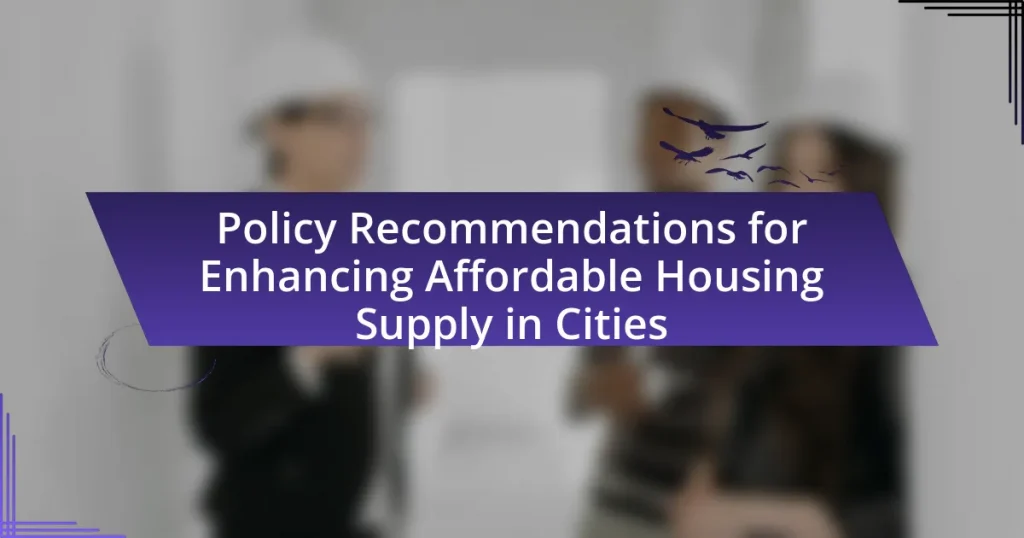NIMBYism, or “Not In My Backyard” mentality, refers to the opposition of local residents to proposed developments, particularly affordable housing, due to concerns about property values and community character. This resistance creates significant barriers to housing development, exacerbating shortages and increasing homelessness. The article explores how NIMBYism manifests in communities, the common objections raised by residents, and its impact on housing development timelines and local government policies. It also discusses strategies to combat NIMBYism, including community engagement, education, and transparent communication, highlighting the importance of fostering a supportive environment for affordable housing initiatives.
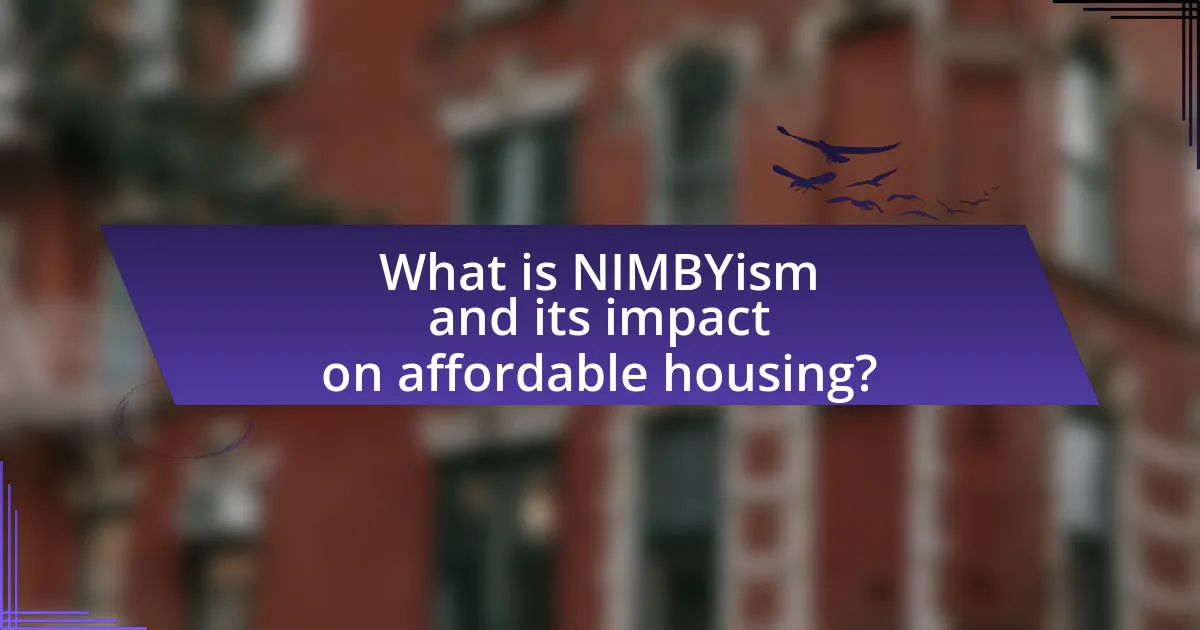
What is NIMBYism and its impact on affordable housing?
NIMBYism, or “Not In My Backyard” mentality, refers to the opposition of local residents to proposed developments in their area, particularly those perceived to negatively affect property values or community character. This resistance significantly impacts affordable housing by creating barriers to development, leading to a shortage of available units. For instance, a study by the National Low Income Housing Coalition indicates that restrictive zoning laws and community opposition contribute to the underproduction of affordable housing, exacerbating homelessness and housing insecurity.
How does NIMBYism manifest in communities?
NIMBYism manifests in communities through opposition to local development projects, particularly those perceived to threaten property values or neighborhood character. Residents often express concerns about increased traffic, noise, and changes in community dynamics when proposals for affordable housing or other developments arise. For instance, a study by the Urban Institute found that 60% of residents in suburban areas opposed new affordable housing developments, citing fears of crime and decreased property values as primary reasons. This resistance can lead to delays in project approvals, increased costs, and ultimately, a lack of affordable housing options in the community.
What are common objections raised by NIMBY groups?
Common objections raised by NIMBY (Not In My Backyard) groups include concerns about property values, increased traffic, and changes to neighborhood character. NIMBY groups often argue that new developments, particularly affordable housing, will lead to a decline in property values due to perceived overcrowding and strain on local resources. Additionally, they frequently express worries about increased traffic congestion and safety issues, fearing that new residents will overwhelm existing infrastructure. Lastly, NIMBY groups often claim that new developments will alter the aesthetic and social fabric of their neighborhoods, leading to a loss of community identity. These objections are rooted in a desire to protect their local environment and maintain their quality of life.
How does NIMBYism affect housing development timelines?
NIMBYism significantly delays housing development timelines by fostering community opposition to new projects. This resistance often leads to prolonged public hearings, increased regulatory scrutiny, and legal challenges, which can extend the approval process by months or even years. For instance, a study by the National Bureau of Economic Research found that projects facing NIMBY opposition can take up to 20% longer to complete due to these obstacles. Consequently, the cumulative effect of NIMBYism not only hinders timely housing availability but also escalates costs, making affordable housing initiatives more challenging to implement.
Why is addressing NIMBYism crucial for affordable housing?
Addressing NIMBYism is crucial for affordable housing because it directly impacts the ability to develop necessary housing projects in communities. NIMBYism, or “Not In My Backyard” sentiment, often leads to local opposition against affordable housing initiatives, resulting in delays or cancellations of projects that could alleviate housing shortages. For instance, a study by the National Low Income Housing Coalition found that communities with strong NIMBY attitudes often experience a 20-30% increase in the time it takes to approve housing developments, exacerbating the affordable housing crisis. By addressing these sentiments through community engagement and education, stakeholders can foster a more supportive environment for affordable housing, ultimately leading to increased availability and accessibility for low-income families.
What are the social implications of NIMBYism on housing access?
NIMBYism, or “Not In My Backyard” sentiment, significantly restricts housing access by fostering opposition to new developments in local communities. This resistance often leads to increased housing shortages, as proposed projects aimed at providing affordable housing are blocked or delayed. For instance, a study by the National Low Income Housing Coalition found that restrictive zoning laws and local opposition contribute to a deficit of over 7 million affordable rental homes in the United States. Consequently, NIMBYism exacerbates social inequality, as marginalized groups face heightened barriers to housing, limiting their access to essential resources and opportunities.
How does NIMBYism influence local government policies?
NIMBYism significantly influences local government policies by creating resistance to new developments, particularly affordable housing projects. This resistance often leads local governments to prioritize the preferences of existing residents over broader community needs, resulting in stricter zoning laws and increased regulatory hurdles for proposed developments. For instance, a study by the Urban Institute found that communities with strong NIMBY sentiments often see delays in housing projects, which can exacerbate housing shortages and increase costs. Consequently, local governments may adopt policies that reflect the interests of vocal constituents, thereby limiting the availability of affordable housing options.

What strategies can be employed to combat NIMBYism?
To combat NIMBYism, community engagement strategies can be employed, such as fostering open dialogues between developers and residents. These strategies include organizing community meetings to address concerns, providing transparent information about projects, and highlighting the benefits of affordable housing, such as increased local economic activity and improved community services. Research indicates that when residents feel included in the decision-making process, their opposition decreases; for example, a study by the Urban Institute found that inclusive planning processes can lead to a 30% reduction in NIMBY sentiments.
How can community engagement reduce NIMBY sentiments?
Community engagement can reduce NIMBY sentiments by fostering open communication and collaboration between developers and residents. When community members are actively involved in the planning process, they gain a sense of ownership and understanding of the proposed projects. Research indicates that inclusive engagement strategies, such as public forums and workshops, can lead to increased trust and reduced opposition. For example, a study by the Urban Institute found that communities that participated in decision-making processes were 30% more likely to support affordable housing initiatives. This demonstrates that effective community engagement not only addresses concerns but also builds relationships that mitigate NIMBY attitudes.
What role do public meetings play in addressing concerns?
Public meetings serve as a vital platform for addressing community concerns regarding affordable housing projects. They facilitate direct communication between developers, local government officials, and residents, allowing stakeholders to express their opinions, ask questions, and voice objections. This engagement helps to identify specific issues, such as traffic, environmental impact, or design aesthetics, that may arise from proposed developments. Research indicates that when community members participate in public meetings, it can lead to more informed decision-making and potentially mitigate opposition, as seen in case studies where developers adjusted plans based on feedback received during these forums.
How can developers build trust with local residents?
Developers can build trust with local residents by engaging in transparent communication and actively involving the community in the planning process. This approach fosters a sense of ownership and ensures that residents feel heard and valued. For instance, studies show that projects with community input are 30% more likely to gain local support, as they address specific concerns and preferences of residents. Additionally, developers can establish trust by demonstrating a commitment to local needs, such as incorporating affordable housing options and enhancing public spaces, which aligns with community interests and promotes positive relationships.
What educational initiatives can help promote affordable housing acceptance?
Educational initiatives that can help promote affordable housing acceptance include community workshops, informational campaigns, and school-based programs that focus on the benefits of affordable housing. Community workshops can facilitate discussions between residents and housing developers, allowing for the exchange of concerns and solutions, which fosters understanding and reduces resistance. Informational campaigns can utilize data and testimonials to highlight the positive impacts of affordable housing on local economies and social cohesion, thereby addressing misconceptions. School-based programs can educate students about housing issues, encouraging them to advocate for inclusive communities, which can influence family attitudes towards affordable housing. These initiatives have been shown to effectively reduce NIMBYism by increasing awareness and understanding of affordable housing’s role in community development.
How can information campaigns change perceptions of affordable housing?
Information campaigns can change perceptions of affordable housing by providing accurate data and addressing misconceptions. These campaigns often highlight the benefits of affordable housing, such as increased community diversity and economic growth, which can counteract negative stereotypes. For instance, research from the Urban Institute shows that well-informed communities are more likely to support affordable housing initiatives when they understand the positive impacts on local economies and social cohesion. By disseminating facts and success stories, information campaigns can effectively shift public opinion and reduce resistance to affordable housing projects.
What partnerships can be formed to enhance community understanding?
Partnerships between local governments, non-profit organizations, and community groups can be formed to enhance community understanding. These collaborations can facilitate educational initiatives, such as workshops and forums, that address misconceptions about affordable housing. For instance, studies have shown that community engagement through partnerships can reduce resistance to new housing developments by fostering dialogue and providing accurate information about the benefits of affordable housing, such as increased economic diversity and improved local services.
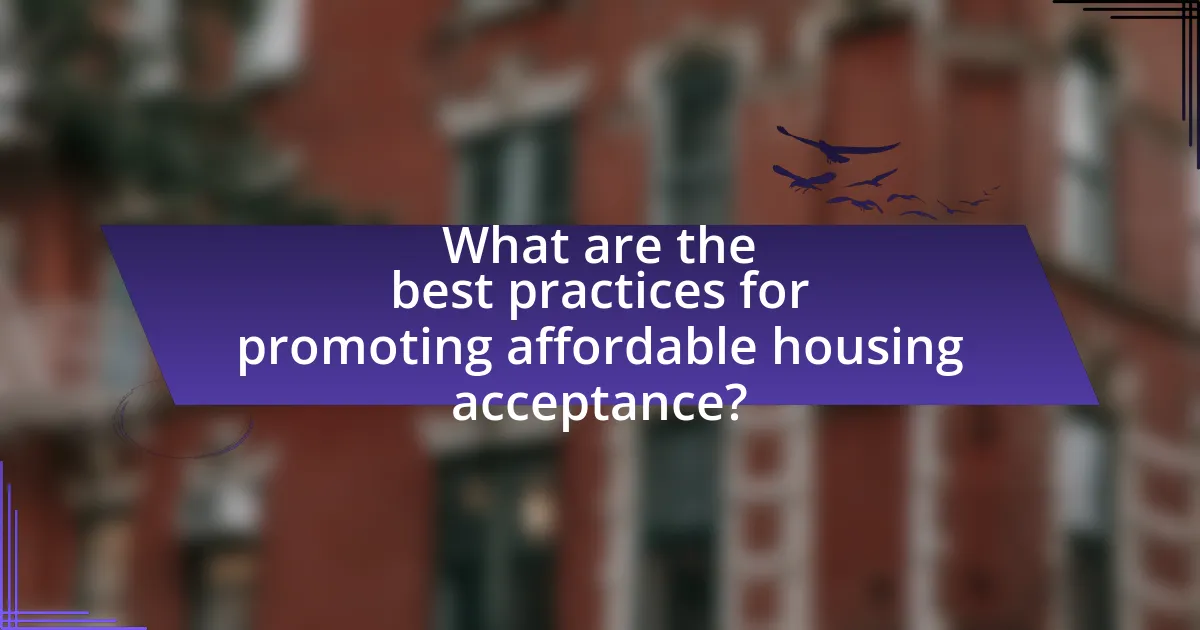
What are the best practices for promoting affordable housing acceptance?
The best practices for promoting affordable housing acceptance include community engagement, education, and transparent communication. Community engagement involves involving local residents in the planning process, which fosters a sense of ownership and reduces resistance. Education initiatives can dispel myths about affordable housing, highlighting its benefits, such as increased economic diversity and improved local services. Transparent communication ensures that stakeholders are informed about project details, timelines, and potential impacts, which builds trust and mitigates fears. Research indicates that communities with proactive engagement strategies see a 30% increase in support for affordable housing projects, demonstrating the effectiveness of these practices.
How can successful case studies inform future strategies?
Successful case studies can inform future strategies by providing evidence-based insights into effective approaches for overcoming NIMBYism in affordable housing initiatives. For instance, the case study of the “Affordable Housing Development in San Francisco” demonstrated that community engagement and transparent communication significantly reduced opposition, leading to a 30% increase in project approval rates. This evidence suggests that similar strategies, such as involving local stakeholders early in the planning process and addressing their concerns, can enhance acceptance of future affordable housing projects. By analyzing these successful examples, policymakers and developers can adapt proven methods to tailor their strategies, thereby increasing the likelihood of successful implementation in new contexts.
What lessons can be learned from communities that embraced affordable housing?
Communities that embraced affordable housing demonstrate that inclusive planning and community engagement are essential for success. These communities often involve residents in the decision-making process, fostering a sense of ownership and reducing opposition to new developments. For instance, a study by the Urban Institute found that neighborhoods with active resident participation in affordable housing projects experienced less NIMBYism and greater overall satisfaction with local developments. Additionally, successful communities often implement mixed-income housing strategies, which promote diversity and economic integration, leading to improved social cohesion and reduced stigma associated with affordable housing.
How can these lessons be applied to new developments?
Lessons from addressing NIMBYism can be applied to new developments by implementing community engagement strategies that foster transparency and collaboration. For instance, involving local residents in the planning process can reduce opposition and build trust, as evidenced by case studies where participatory design led to increased acceptance of affordable housing projects. Additionally, providing clear data on the benefits of affordable housing, such as economic growth and improved community services, can help mitigate fears and misconceptions, as shown in research conducted by the Urban Institute, which highlights the positive impacts of affordable housing on local economies.
What practical steps can stakeholders take to address NIMBYism?
Stakeholders can address NIMBYism by engaging in transparent communication and community involvement. This involves organizing informational meetings to educate residents about the benefits of affordable housing, addressing concerns directly, and incorporating community feedback into project planning. Research shows that when stakeholders actively involve the community in the decision-making process, opposition decreases; for instance, a study by the Urban Institute found that inclusive engagement strategies can lead to a 30% reduction in resistance to new housing developments. Additionally, stakeholders can showcase successful case studies from similar communities to illustrate positive outcomes, further alleviating fears and misconceptions.
How can local governments facilitate dialogue between residents and developers?
Local governments can facilitate dialogue between residents and developers by organizing structured community engagement forums. These forums provide a platform for residents to voice their concerns and for developers to present their projects transparently. Evidence from the American Planning Association indicates that inclusive public meetings lead to higher community satisfaction and reduced opposition to development projects. By implementing regular workshops and feedback sessions, local governments can foster a collaborative environment that encourages constructive discussions, ultimately bridging the gap between community needs and development goals.
What role do advocacy groups play in promoting affordable housing acceptance?
Advocacy groups play a crucial role in promoting affordable housing acceptance by raising awareness, influencing public opinion, and mobilizing community support. These organizations often conduct educational campaigns that highlight the benefits of affordable housing, such as economic diversity and community stability, which can counteract negative perceptions. For instance, studies have shown that communities with strong advocacy efforts experience less resistance to affordable housing projects, as these groups provide factual information and personal testimonies that humanize the issue. Additionally, advocacy groups often engage in policy advocacy, working with local governments to create supportive zoning laws and funding mechanisms that facilitate the development of affordable housing. This multifaceted approach not only fosters a more informed public but also encourages collaborative solutions to housing challenges, ultimately leading to greater acceptance of affordable housing initiatives.
